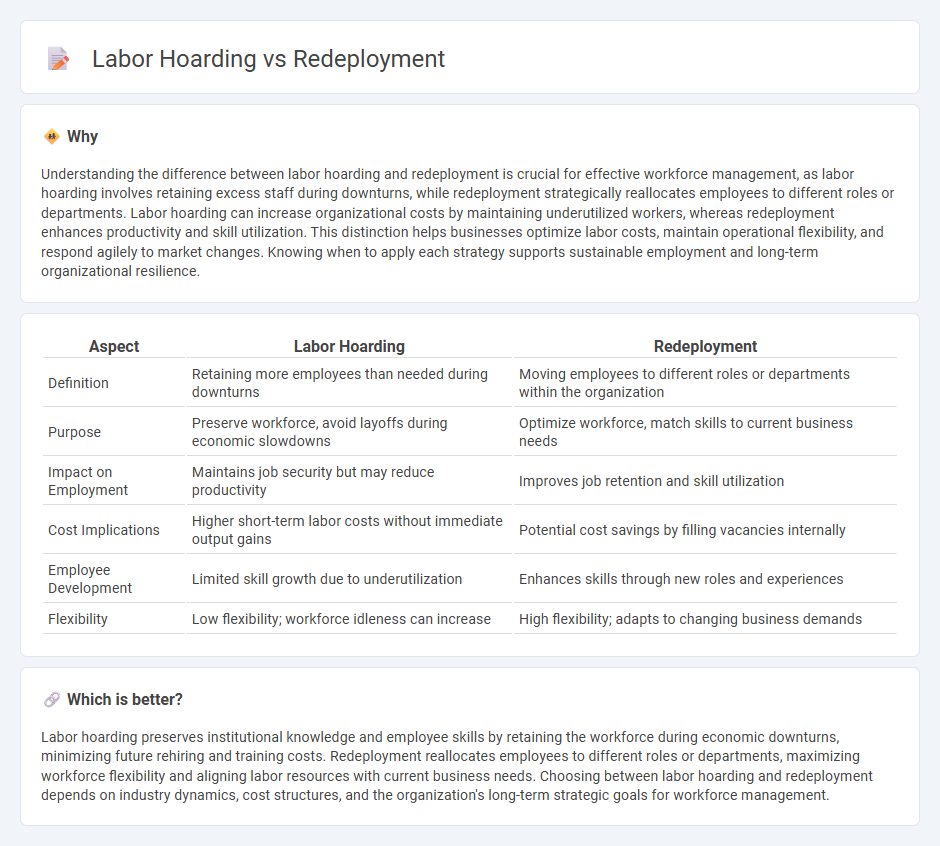
Labor hoarding occurs when firms retain excess employees during downturns to preserve skills and avoid rehiring costs, impacting short-term productivity and long-term stability. Redeployment shifts workers to different roles or departments to maximize resource utilization and adapt to changing business needs efficiently. Explore more about how strategic labor management influences organizational resilience and workforce optimization.
Why it is important
Understanding the difference between labor hoarding and redeployment is crucial for effective workforce management, as labor hoarding involves retaining excess staff during downturns, while redeployment strategically reallocates employees to different roles or departments. Labor hoarding can increase organizational costs by maintaining underutilized workers, whereas redeployment enhances productivity and skill utilization. This distinction helps businesses optimize labor costs, maintain operational flexibility, and respond agilely to market changes. Knowing when to apply each strategy supports sustainable employment and long-term organizational resilience.
Comparison Table
| Aspect | Labor Hoarding | Redeployment |
|---|---|---|
| Definition | Retaining more employees than needed during downturns | Moving employees to different roles or departments within the organization |
| Purpose | Preserve workforce, avoid layoffs during economic slowdowns | Optimize workforce, match skills to current business needs |
| Impact on Employment | Maintains job security but may reduce productivity | Improves job retention and skill utilization |
| Cost Implications | Higher short-term labor costs without immediate output gains | Potential cost savings by filling vacancies internally |
| Employee Development | Limited skill growth due to underutilization | Enhances skills through new roles and experiences |
| Flexibility | Low flexibility; workforce idleness can increase | High flexibility; adapts to changing business demands |
Which is better?
Labor hoarding preserves institutional knowledge and employee skills by retaining the workforce during economic downturns, minimizing future rehiring and training costs. Redeployment reallocates employees to different roles or departments, maximizing workforce flexibility and aligning labor resources with current business needs. Choosing between labor hoarding and redeployment depends on industry dynamics, cost structures, and the organization's long-term strategic goals for workforce management.
Connection
Labor hoarding occurs when companies retain more employees than immediately necessary, anticipating future demand fluctuations. Redeployment enhances this strategy by reallocating surplus labor to different departments or roles, maximizing workforce utilization without layoffs. Together, labor hoarding and redeployment help businesses maintain operational flexibility and preserve human capital during economic uncertainty.
Key Terms
Workforce flexibility
Redeployment enhances workforce flexibility by reallocating employees to different roles or departments based on business needs, optimizing skill utilization and reducing redundancies. Labor hoarding maintains excess workforce capacity to preserve job stability during downturns, prioritizing employee retention over immediate productivity gains. Explore strategies to balance redeployment and labor hoarding for agile workforce management.
Talent allocation
Redeployment optimizes talent allocation by reallocating employees to areas with higher demand or strategic importance, enhancing workforce flexibility and productivity. Labor hoarding retains employees during downturns despite reduced workload, aiming to preserve skills and avoid future recruitment costs. Explore more on how strategic talent allocation impacts organizational agility and efficiency.
Personnel retention
Redeployment involves reallocating employees to different roles or departments to optimize workforce utilization, while labor hoarding refers to retaining more workers than immediately necessary to preserve institutional knowledge and employee morale. Both strategies are critical for personnel retention, as redeployment offers career development opportunities and labor hoarding provides job security during economic fluctuations. Explore detailed insights on how these approaches enhance workforce stability and retention.
Source and External Links
Redeployment: A Guide for HR Managers & Employers - Personio - Redeployment is the process of moving an employee from one job role to another within the same company, often to avoid redundancies, involving offering suitable alternative employment, a trial period in the new role, and confirmation of the redeployment.
Redeployment: Overview, definition, and example - Cobrief - Redeployment refers to reassigning employees within an organization to different roles, departments, or locations to align workforce with shifting business needs and to minimize layoffs, optimize employee utilization, and maintain operational flexibility.
What Is Redeployment? - Staffing Network - Redeployment is the internal movement of employees to fill vacancies, save on recruitment costs, promote adaptability, and maintain positive company culture, often involving training and support during the transition.
 dowidth.com
dowidth.com